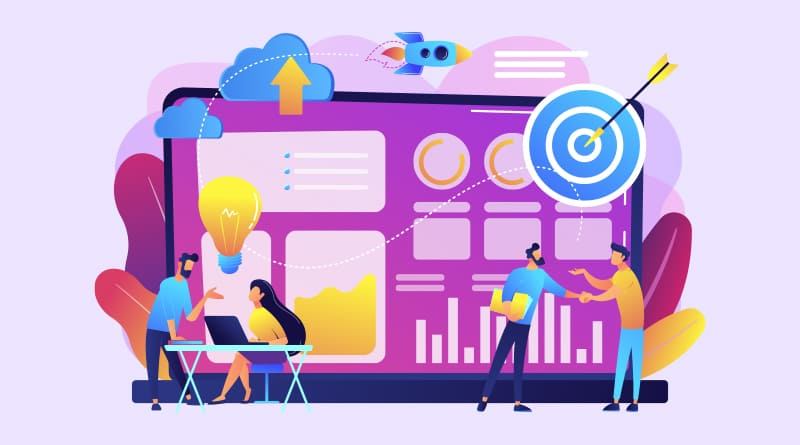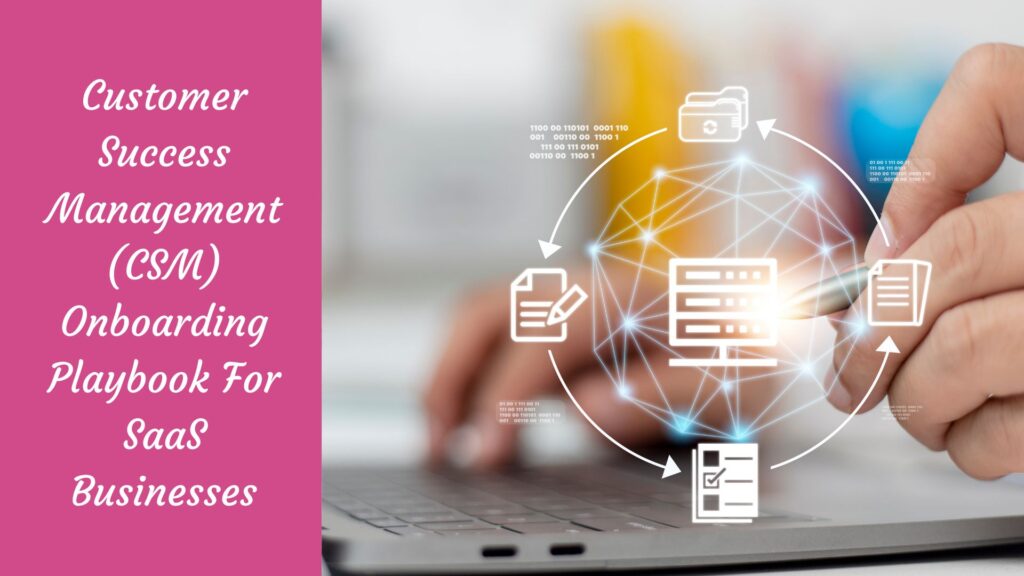In today’s fast-paced digital world, SaaS businesses face a significant challenge in keeping customers happy and engaged. The key to growth and retention lies in effective customer success management.
However, getting this right from the start with efficient onboarding can be tricky and, if not done well, may lead to frustrated customers and lost opportunities. That’s where our blog comes into play.
We’ve created the ultimate Customer Success Management (CSM) Onboarding Playbook specifically tailored for SaaS businesses, packed with strategies and insights to ensure your customers stay satisfied, engaged, and committed to your service.
Don’t miss out on unlocking the full potential of your customer success team.
Section 1: Understanding the Importance of CSM Onboarding

Customer Success Management (CSM) isn’t just a fancy term in the SaaS industry; it’s the backbone of creating raving fans out of your users. We’re talking about turning sign-ups into die-hard aficionados of your product who wouldn’t dream of switching to a competitor.
How? Through killer onboarding experiences that make every user feel like your product was made with them in mind.
The Role of CSM in SaaS Success
Definition and Scope of Customer Success Management
At its heart, Customer Success Management is about ensuring customers achieve their desired outcomes while using your SaaS product. This might sound like a no-brainer, but it’s a nuanced blend of support, education, and relationship-building.
Imagine you’ve just signed up for a new app to manage your emails better. You’d be pretty stoked if you received personalized guidance on setting up your most productive workflow, right? That’s CSM in action.
Key Metrics for Measuring CSM Impact
- Churn Rate: How many customers are bailing on you? Lower numbers are better here.
- Customer Lifetime Value (CLV): Basically, how much dough a customer will bring in over their lifetime.
- Net Promoter Score (NPS): This tells you how likely it is your customers will play the role of your hype man.
The Business Value of Effective Onboarding
Reducing Churn Rates
Improving your onboarding process can dramatically decrease your churn rate. Think about it; when customers feel confident using your product from the get-go, they’re less likely to jump ship. Offering a mix of tutorials, FAQs, and live support can make all the difference. Find some insights on reducing churn at HubSpot’s Customer Service Blog.
Enhancing Customer Lifetime Value (CLV)
Customers who stick around longer and are happy with your service tend to spend more. Simple, right? Effective onboarding makes sure customers fully grasp the value of your product, making them more likely to upgrade and shout your praises from the rooftops. Forbes dives deeper into the importance of customer success for sustainability.
Improving Product Adoption and Satisfaction
A smooth onboarding experience ensures that customers don’t just sign up but actually use your product to its fullest potential. When your users feel like they’re winning because of your product, they’re going to stick around – and maybe even become evangelists for your brand. Tailoring the onboarding process to individual needs and showcasing quick wins can create a legion of satisfied customers. Insights on improving product adoption can be found at Intercom’s blog.
Incorporating these strategies within your CSM can transform the way your customers perceive and interact with your service. Remember, the goal is to make your users feel like the heroes of their own stories – with your SaaS product as their indispensable sidekick.
Building Your CSM Onboarding Strategy

Setting Clear Objectives for Onboarding
Before you kick things off, you’ve gotta know where you’re headed, right? That’s the deal with onboarding. Setting clear objectives is like plotting your route on a map before a road trip.
Identifying Key Success Metrics
First up, figure out how you’ll measure success. Here’s a simple breakdown:
- Adoption Rate: Are folks actually using your product after they sign up? An uptick here means you’re doing something right.
- Customer Satisfaction (CSAT): This is straight-up asking your customers how you’re doing on a scale. Higher scores? You’re golden.
- First Value Delivery (FVD): How fast do your customers get to that “aha” moment with your product? Quicker is better.
Aligning Objectives with Business Goals
Your onboarding goals gotta sync up with your bigger business ambitions. If you’re aiming to be the go-to tool for project management, your onboarding should make users pros at using your features to manage their projects efficiently.
Personalization in CSM Onboarding
No two customers are the same, so why treat ’em that way? Personalization is key.
Understanding Customer Segments
Break down your audience. You might have small businesses, freelancers, and big corporations all in your user base. Each has different needs and pain points.
Tailoring Onboarding Experiences
Craft your onboarding to speak directly to each segment. For freelancers, highlight ease of use and flexibility. For corporations, stress scalability and security. It’s like choosing a playlist that perfectly fits your mood.
Leveraging Technology in CSM Onboarding
Tech isn’t just flashy; it’s a game-changer in delivering efficient, scalable onboarding.
Tools and Platforms for Scalable Onboarding Processes
There’s a plethora of tools out there. Zendesk for customer support, Intercom for messaging, and Trello for tracking onboarding tasks. Picking the right mix will help you streamline and manage the onboarding process like a boss.
Integrating AI and Automation for Efficiency
AI and automation aren’t just buzzwords. They’re revolutionizing how we onboard. Chatbots can guide new users through setup processes, and automated emails can deliver personalized content at just the right time in the user’s journey.
By nailing down your objectives, personalizing the experience, and leveraging the right tech, you’ll be on your way to turning new sign-ups into loyal fans. Remember, a superb onboarding experience sets the tone for the entire customer relationship.
Key Components of a Successful CSM Onboarding Program

Pre-Onboarding Engagement
Welcome Emails and Initial Communications
Right off the bat, you’ll want to kick things off with a bang. Welcome emails are your first hi-five with new users. Make it count! Crafting a friendly, informative welcome message can set a positive tone. Here’s the deal:
- Personalize it: Throw in their name, mention what they’re gonna love about your service. It makes a huge difference.
- Keep it clear and engaging: No one likes a novel in their inbox. Quick, punchy sentences work best.
Check out Mailchimp’s guide for top-notch welcome email tips.
Setting Expectations and Next Steps
Clarity is key. Right from the get-go, users should know what’s coming next. It’s like when you order online, and you get that tracking link. Peace of mind, right?
- Outline the Onboarding Process: Quick bullet points on what they should expect in the coming days.
- Actionable Next Steps: Guide them on what to do next. Maybe it’s setting up their profile, or checking out an intro video.
For tips on setting clear expectations, peek at HubSpot’s guide.
Interactive Onboarding Sessions
Webinars, Workshops, and One-on-One Meetings
Feeling connected matters. Offering live sessions like webinars or workshops makes things personal. It’s your chance to show off the human side of your biz. Plus, one-on-one meetings? Goldmine for tailored support.
- Utilize platforms like Zoom or Webex: Perfect for those interactive sessions. Zoom’s blog has some epic tips for engaging webinars.
- Schedule sessions based on user availability: Makes it easy for them to join in.
Gamification and Interactive Learning Tools
Ever play a game just “one more time” to beat your score? That’s gamification working its magic. Applying game design elements in non-game contexts, like onboarding, boosts engagement and learning.
- Leaderboards, points, or badges for completing steps: It turns learning into a challenge. Fun, right?
- Tools like Kahoot! or Quizizz: Who said learning can’t be fun? Gamify your onboarding and watch engagement soar. Check out Kahoot!’s website for ideas.
Ongoing Support and Resources
Access to Knowledge Bases and FAQs
Having a go-to spot for self-help can empower your users. It’s like having a library at their fingertips.
- Keep it updated: Regularly refresh with new info and guides.
- Make it searchable: Users should find answers faster than Google can say, “did you mean…?”
For building a killer knowledge base, Zendesk has you covered.
Regular Check-Ins and Feedback Loops
The convo shouldn’t stop after onboarding. Checking in shows you care beyond the signup.
- Schedule check-ins: Could be via email, a quick call, or even a survey.
- Act on feedback: Shows you’re listening and willing to adapt.
Survey tools like SurveyMonkey or Google Forms can make gathering feedback a breeze.
By weaving these components into your CSM onboarding program, you’re not just signing up a user; you’re welcoming them into a community. It’s about making them feel at home, guided, and heard throughout their entire journey with your product.
Overcoming Common CSM Onboarding Challenges

Addressing Resistance to Change
Strategies for Encouraging Adoption
Tackling resistance head-on means making change feel less like a chore and more like a compelling journey. Imagine you’re introducing a new project management tool. Instead of just sending out an email that says, “Hey, we’re switching to this,” try these tactics:
- Highlight the Benefits: A short video showcasing how the new tool can cut down weekly reporting time could spark interest.
- Peer Champions: Identify early adopters who can share positive experiences and practical tips with their coworkers.
Change Management provides detailed strategies on managing and encouraging adoption.
Communicating the Value of New Processes
Clear communication is key. If you’re rolling out a new feedback system, don’t just focus on how to use it. Dig into the “why”. For instance:
- Client Stories: Share real-life scenarios where feedback led to tangible improvements in the service.
- Visual Aids: Infographics showing improved customer satisfaction scores can visually communicate the benefits.
Effective Communication Strategies on PMI can give you more insights on this topic.
Scaling Onboarding for Different Customer Sizes
Customizing Onboarding for SMBs vs. Enterprise Clients
The one-size-fits-all approach doesn’t cut it when it comes to customer sizes. Quick and easy setup guides are golden for SMBs (Small and Medium-Sized Businesses). They’re looking for efficiency and simplicity. On the other hand, enterprise clients might value more detailed strategic planning sessions focusing on integration and scalability.
Check out Gartner’s insights for adapting strategies for different business sizes.
Balancing Automation and Personal Touch
It’s about finding that sweet spot. For instance, automated emails can efficiently guide a new user through initial steps. But complementing this with personal check-ins via Zoom offers that human touch, showing real people behind the service.
Salesforce’s take on Personalization dives deeper into balancing these aspects.
Measuring and Adjusting Your Onboarding Process
Key Performance Indicators (KPIs) for Onboarding Success
You can’t improve what you don’t measure. Start with KPIs like:
- Customer satisfaction scores post-onboarding
- Time to first value: How quickly users find value in your service
- Adoption rates for new features or processes
HubSpot’s Guide on KPIs is a great resource for identifying and tracking these metrics.
Iterating Based on Feedback and Data
The end of the onboarding process is just the beginning. Use surveys and feedback tools to gather user perceptions. Combine this qualitative data with the quantitative insights from your KPIs. This dual lens approach enables you to refine and tweak the onboarding experience, ensuring it remains relevant and effective.
For practical steps on iterating based on feedback, SurveyMonkey’s guide on implementing and learning from feedback surveys can offer further clarification.
By addressing these challenges with smart strategies, engaging communication, and continuous improvement, your CSM onboarding experience can become a major asset in building lasting customer relationships.
Best Practices and Trends in CSM Onboarding for SaaS

Incorporating Latest Trends
The Role of AI and Machine Learning in Personalization
In the fast-paced world of SaaS, staying ahead means leveraging cutting-edge tech like AI and machine learning. These aren’t just buzzwords; they’re game-changers in personalizing the onboarding experience. For instance:
- Netflix uses AI to tailor recommendations, making users feel understood from day one (Netflix Machine Learning).
- Chatbots on platforms like Zendesk offer personalized support, guiding users through setup without waiting on human reps (Zendesk Chatbots).
Utilizing Data Analytics for Continuous Improvement
Data analytics turn raw numbers into actionable insights, ensuring your onboarding process evolves with your users. Big players like Google Analytics help track user interaction, highlighting what’s working and what’s not (Google Analytics).
- Heat maps show where users click most often, indicating popular features or confusing areas.
- Conversion rates from sign-up to active use can pinpoint where users drop off, allowing for targeted improvements.
Best Practices for a Seamless Onboarding Experience
Clear Communication and Transparency
Nothing beats clear, straightforward communication. Tools like Slack or Zoom can help maintain open lines, ensuring users know what to expect and when (Slack, Zoom).
- Set clear milestones – What should users achieve by day 1, week 1, month 1?
- Be upfront about potential hiccups – A little honesty goes a long way in building trust.
Building a Community Around Your SaaS Product
Community is key. It’s not just about troubleshooting; it’s about belonging. Platforms like Discord or online forums can foster this sense of community, offering users a place to share tips, triumphs, and even grievances in a supportive environment (Discord).
- Weekly AMA (Ask Me Anything) sessions with your product team can deepen user engagement.
- User-generated content contests can celebrate successful onboarding stories, encouraging participation.
Case Studies: Successful CSM Onboarding in Action
Lessons Learned from Leading SaaS Companies
Salesforce, a giant in the CRM space, nails personalization by assigning a success manager to each new client, ensuring a clear, personalized onboarding path from the get-go (Salesforce).
- Dropbox simplifies its onboarding with clear, engaging tutorials that make first-time users feel like pros in no time (Dropbox Guide).
Adapting Strategies for Your Business
What works for the big names might not fit your blueprint exactly, but the principles remain the same.
- Start small: Implement AI chat support to answer basic queries.
- Gather data: Use tools like Hotjar to understand user behavior on your site (Hotjar).
- Build community: Create a welcoming space on platforms like LinkedIn or Reddit relevant to your niche.
By plucking the best practices from leading SaaS companies and integrating the latest tech and data analytics, your CSM onboarding can transform from a mere process to a dynamic, engaging experience. Remember, at the heart of successful onboarding is the understanding that each user’s success is your success.
FAQs
1. What Is the Impact of AI and Machine Learning on CSM Onboarding for SaaS Businesses?
Trending Insight:
AI and machine learning are revolutionizing CSM onboarding by enabling personalized experiences at scale. These technologies can analyze customer data to predict needs, automate routine tasks, and provide insights for continuous improvement.
2. How Can SaaS Businesses Measure the Success of Their CSM Onboarding Efforts?
Interesting Angle:
Success measurement goes beyond traditional metrics like churn rate. Advanced analytics and customer health scores, including engagement levels and product adoption rates, offer a more nuanced view of onboarding effectiveness.
3. What Are the Latest Trends in Leveraging Data Analytics for CSM Onboarding?
Trending Insight:
The use of predictive analytics to tailor onboarding experiences is a hot trend. By analyzing customer behavior patterns, SaaS businesses can preemptively address potential challenges, ensuring a smoother onboarding process.
4. How Can SaaS Companies Personalize Onboarding at Scale?
Interesting Angle:
SaaS businesses are adopting segmentation and automation to personalize onboarding without sacrificing efficiency. Companies can deliver customized onboarding paths using automated workflows by categorizing customers based on their needs and behaviors.
5. What Role Does Customer Feedback Play in Optimizing CSM Onboarding Processes?
Trending Insight:
Customer feedback is now more crucial than ever in shaping onboarding processes. Real-time feedback mechanisms, such as surveys and interactive tools, allow SaaS businesses to make immediate adjustments, enhancing the overall customer experience.
Conclusion
Effective CSM onboarding is crucial for any SaaS business looking to retain customers and ensure they get the most out of your product. Here’s breaking it down in simple words, integrating some SEO goodness, and providing examples for a clearer understanding:
Why Effective Onboarding Matters
- Think of onboarding like teaching someone to fish; you’re not just giving them the fish (your product) but teaching them how to use it for maximum benefit. This improves customer satisfaction and loyalty.
- Example: Slack’s Onboarding Process helps new users from feeling lost to becoming power users through clear guides and actionable steps.
Personalization is Key
- Just like how Netflix recommends shows you might like, personalizing the onboarding experience makes users feel valued and understood.
- Example: Salesforce’s personalized onboarding tailors the user experience based on individual needs and business types.
Feedback Loops
- Always listen to what your users are saying. Tools like SurveyMonkey make it easy to gather feedback and adjust your onboarding process accordingly.
Community Support
- Building a community around your product can be a game-changer. It’s like having a group of friends or mentors available 24/7 to guide you through any issues.
- Example: Discord hosts various community servers where users can exchange tips and support each other, enhancing the overall user experience.
Utilize Analytics
- Insights from analytics tools, such as Google Analytics, are like having a roadmap that shows where you’re losing users and where they’re most engaged. This data is gold when refining your onboarding process.
Continuous Improvement
- The learning never stops. Always be on the lookout for trends, such as AI for personalization or the latest in community-building strategies, to keep your onboarding process fresh and effective.
Case in Point
- Example: Dropbox excels at making complex processes feel simple for new users, ensuring they understand how to get the most out of the platform from day one.
In conclusion, whether it’s leveraging personalization like Netflix, building communities similar to Discord, or utilizing analytics akin to Google Analytics, integrating these strategies into your CSM onboarding process can significantly uplift your user experience.
Just like how keywords and SERPs are to SEO, understanding and implementing these onboarding practices are vital to your SaaS’s customer success and satisfaction.

10+ years experience in Marketing and Operations
